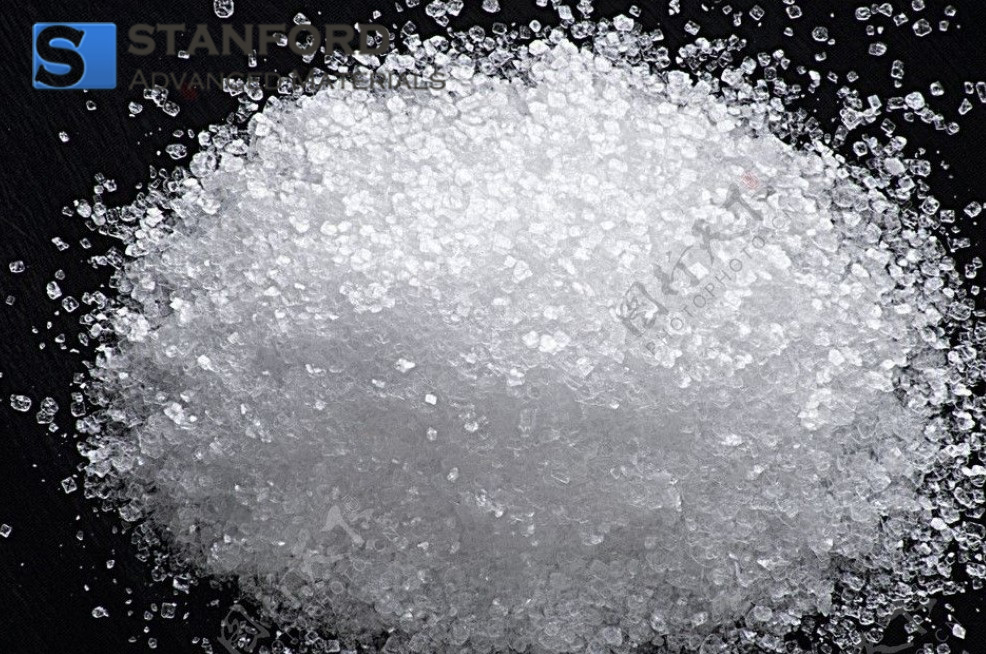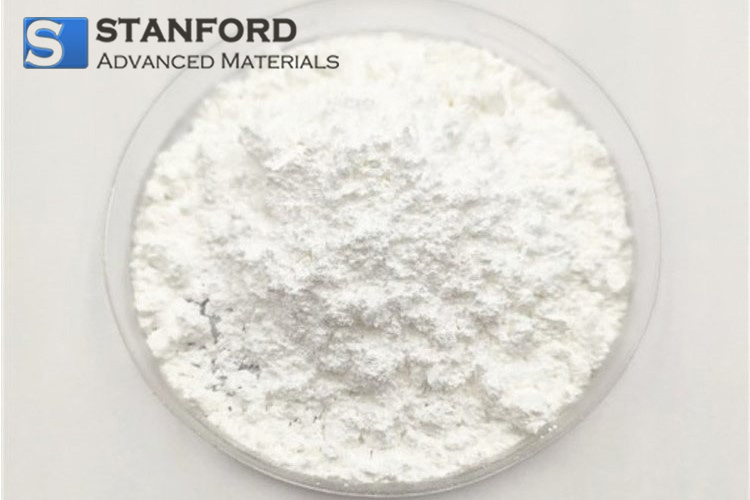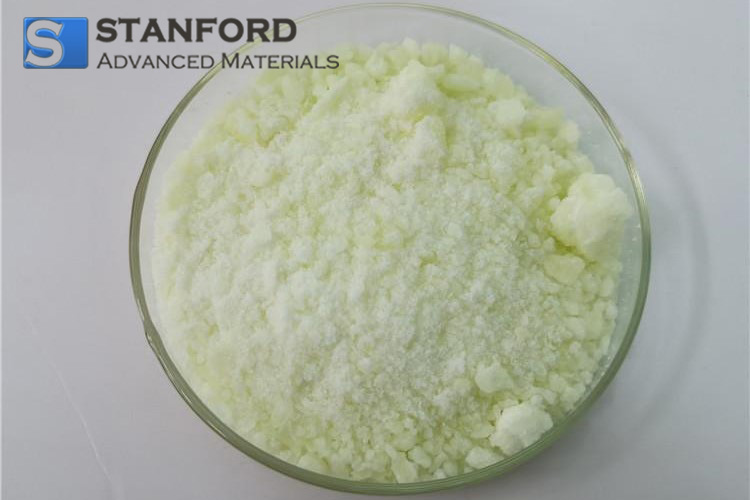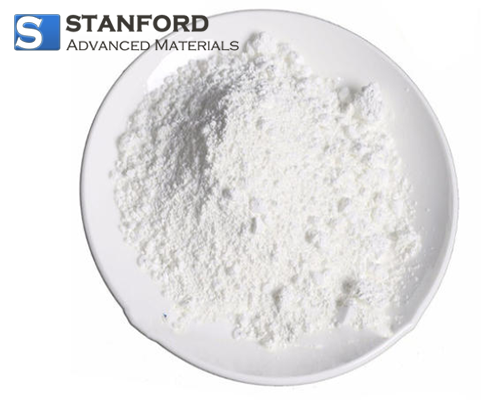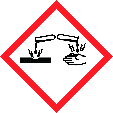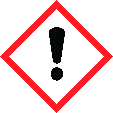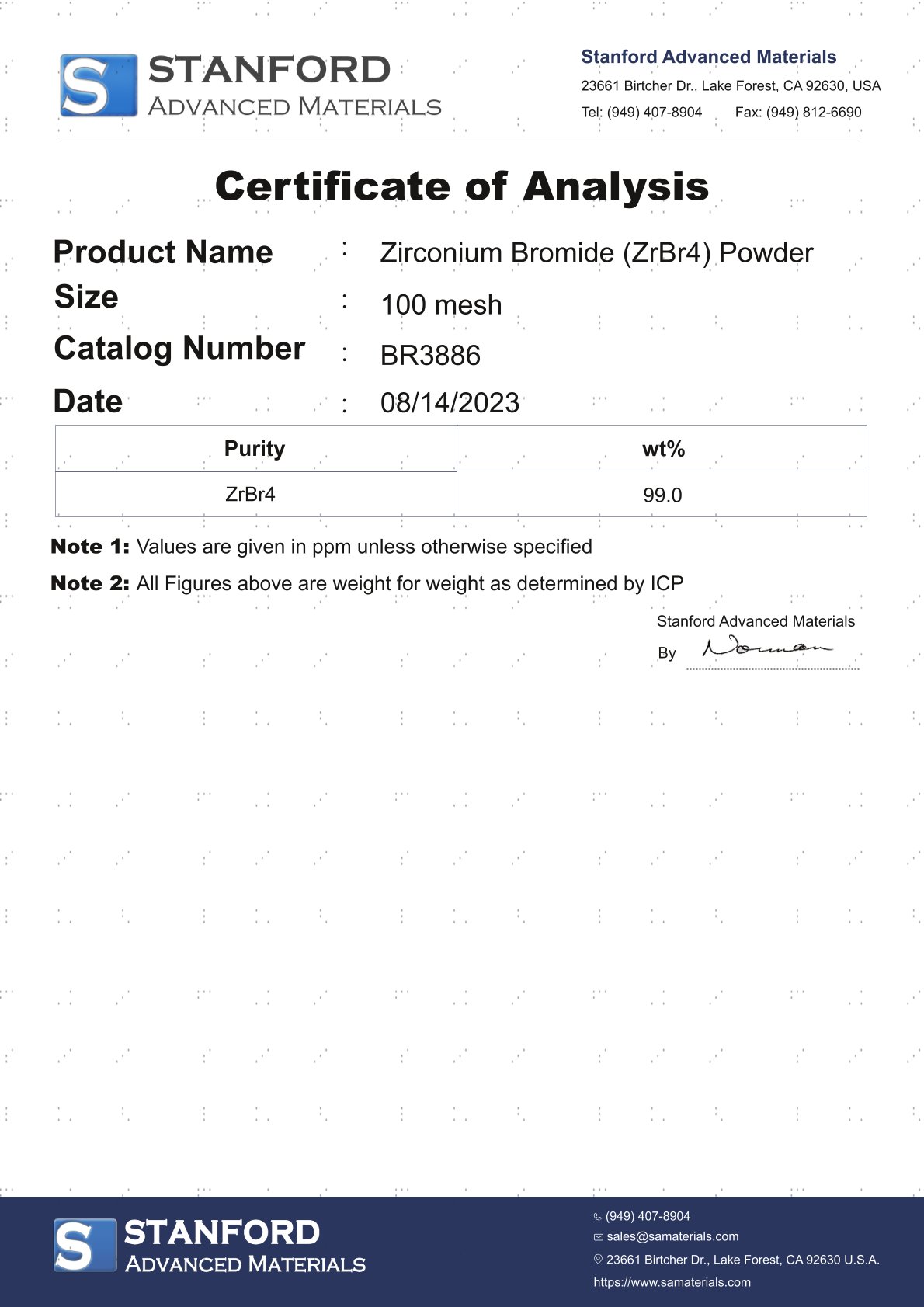SECTION 1. IDENTIFICATION
Product Name: Zirconium Bromide (ZrBr4)
CAS #: 13777-25-8
Relevant identified uses of the substance: Scientific research and development
Supplier details:
Stanford Advanced Materials
E-mail: sales@samaterials.com
Tel: (949) 407-8904
Address: 23661 Birtcher Dr., Lake Forest, CA 92630 U.S.A.
SECTION 2. HAZARDS IDENTIFICATION
Classification
This chemical is considered hazardous by the 2012 OSHA Hazard Communication Standard (29 CFR
1910.1200)
Skin Corrosion/Irritation Category 1 B
Serious Eye Damage/Eye Irritation Category 1
Specific target organ toxicity (single exposure) Category 3
Target Organs - Respiratory system.
Label Elements
Signal Word
Danger
Hazard Statements
Causes severe skin burns and eye damage
May cause respiratory irritation
Precautionary Statements
Prevention
Do not breathe dust/fume/gas/mist/vapors/sprayWash face, hands and any exposed skin thoroughly after handling
Wear protective gloves/protective clothing/eye protection/face protection
Use only outdoors or in a well-ventilated area
Response
Immediately call a POISON CENTER or doctor/physician
Inhalation
IF INHALED: Remove victim to fresh air and keep at rest in a position comfortable for breathing
Skin
IF ON SKIN (or hair): Take off immediately all contaminated clothing. Rinse skin with water/shower
Wash contaminated clothing before reuse
Eyes
IF IN EYES: Rinse cautiously with water for several minutes. Remove contact lenses, if present and
easy to do. Continue rinsing
Ingestion
IF SWALLOWED: Rinse mouth. DO NOT induce vomiting
Storage
Store locked up
Store in a well-ventilated place. Keep container tightly closed
Disposal
Dispose of contents/container to an approved waste disposal plant
Hazards not otherwise classified (HNOC)
None identified
SECTION 3. COMPOSITION/INFORMATION ON INGREDIENTS
· Chemical characterization: Substances
· CAS No. Description
13777-25-8 Zirconium(IV) bromide, 98% (99+%-Zr)
· Identification number(s)
· EC number: 237-417-4
SECTION 4. FIRST AID MEASURES
· Description of first aid measures
· General information: Immediately remove any clothing soiled by the product.
· After inhalation: In case of unconsciousness place patient stably in side position for transportation.
· After skin contact: Immediately wash with water and soap and rinse thoroughly.
· After eye contact: Rinse opened eye for several minutes under running water. Then consult a doctor.
· After swallowing: Drink copious amounts of water and provide fresh air. Immediately call a doctor.
· Information for doctor:
· Most important symptoms and effects, both acute and delayed No further relevant information
available.
· Indication of any immediate medical attention and special treatment needed
No further relevant information available.
SECTION 5. FIREFIGHTING MEASURES
· Extinguishing media
· Suitable extinguishing agents:
CO2, extinguishing powder or water spray. Fight larger fires with water spray or alcohol resistant foam.· Special hazards arising from the substance or mixture
During heating or in case of fire poisonous gases are produced.
· Advice for firefighters
· Protective equipment: Mouth respiratory protective device.
SECTION 6. ACCIDENTAL RELEASE MEASURES
· Personal precautions, protective equipment and emergency procedures
Mount respiratory protective device.
Wear protective equipment. Keep unprotected persons away.
· Environmental precautions: No special measures required.
· Methods and material for containment and cleaning up:
Use neutralizing agent.
Dispose contaminated material as waste according to item 13.
Ensure adequate ventilation.
· Reference to other sections
See Section 7 for information on safe handling.
See Section 8 for information on personal protection equipment.
See Section 13 for disposal information.
SECTION 7. HANDLING AND STORAGE
· Handling:
· Precautions for safe handling
Thorough dedusting.
Ensure good ventilation/exhaustion at the workplace.
Open and handle receptacle with care.
· Information about protection against explosions and fires: Keep respiratory protective device
available.
· Conditions for safe storage, including any incompatibilities
· Storage:
· Requirements to be met by storerooms and receptacles: No special requirements.
· Information about storage in one common storage facility: Not required.
· Further information about storage conditions:
Keep receptacle tightly sealed.
Store in cool, dry conditions in well sealed receptacles.
· Specific end use(s) No further relevant information available.
SECTION 8. EXPOSURE CONTROLS/PERSONAL PROTECTION
· Additional information about design of technical systems: No further data; see item 7.
· Control parameters
· Components with limit values that require monitoring at the workplace: Not required.
· Additional information: The lists that were valid during the creation were used as basis.
· Exposure controls
· Personal protective equipment:
· General protective and hygienic measures:
Keep away from foodstuffs, beverages and feed.
Immediately remove all soiled and contaminated clothing.
Wash hands before breaks and at the end of work.Avoid contact with the eyes.
Avoid contact with the eyes and skin.
· Breathing equipment:
In case of brief exposure or low pollution use respiratory filter device. In case of intensive or longer
exposure use respiratory protective device that is independent of circulating air.
· Protection of hands:
Protective gloves
The glove material has to be impermeable and resistant to the product/ the substance/ the
preparation.
Due to missing tests no recommendation to the glove material can be given for the product/ the
preparation/ the chemical mixture.
Selection of the glove material on consideration of the penetration times, rates of diffusion and the
degradation
· Material of gloves
The selection of the suitable gloves does not only depend on the material, but also on further marks of
quality and varies from manufacturer to manufacturer.
· Penetration time of glove material
The exact break through time has to be found out by the manufacturer of the protective gloves and
has to be observed.
· Eye protection:
Tightly sealed goggles
SECTION 9. PHYSICAL AND CHEMICAL PROPERTIES
· Information on basic physical and chemical properties
· General Information
· Appearance:
Form: Powder
Color: Whitish
· Odor: Pungent
· Odor threshold: Not determined.
· pH-value: Not applicable.
· Change in condition
Melting point/Melting range: 450 °C (842 °F) (15 atm)
Boiling point/Boiling range: no data °C
· Flash point: Not applicable.
· Flammability (solid, gaseous): Not determined.
· Ignition temperature:
Decomposition temperature: Not determined.
· Auto igniting: Not determined.
· Danger of explosion: Product does not present an explosion hazard.
· Explosion limits:
Lower: Not determined.
Upper: Not determined.
· Vapor pressure: no data hPa
· Density at 20 °C (68 °F): 4.201 g/cm³ (35.057 lbs/gal)
· Relative density Not determined.
· Vapor density Not applicable.
· Evaporation rate Not applicable.
· Solubility in / Miscibility with
Water: Insoluble.
· Partition coefficient (n-octanol/water): Not determined.
· Viscosity:Dynamic: Not applicable.
Kinematic: Not applicable.
· Solvent content:
Organic solvents: 0.0 %
VOC content: 0.0 g/l / 0.00 lb/gl
Solids content: 100.0 %
· Other information No further relevant information available.
SECTION 10. STABILITY AND REACTIVITY
· Reactivity No further relevant information available.
· Chemical stability
· Thermal decomposition / conditions to be avoided: No decomposition if used according to
specifications.
· Possibility of hazardous reactions No dangerous reactions known.
· Conditions to avoid No further relevant information available.
· Incompatible materials: No further relevant information available.
· Hazardous decomposition products: No dangerous decomposition products known.
SECTION 11. TOXICOLOGICAL INFORMATION
· Information on toxicological effects
· Acute toxicity:
· Primary irritant effect:
· on the skin: Strong caustic effect on skin and mucous membranes.
· on the eye:
Strong caustic effect.
Strong irritant with the danger of severe eye injury.
· Sensitization: No sensitizing effects known.
· Additional toxicological information:
Swallowing will lead to a strong caustic effect on mouth and throat and to the danger of perforation of
esophagus and stomach.
· Carcinogenic categories
· IARC (International Agency for Research on Cancer)
Substance is not listed.
· NTP (National Toxicology Program)
Substance is not listed.
· OSHA-Ca (Occupational Safety & Health Administration)
Substance is not listed.
SECTION 12. ECOLOGICAL INFORMATION
· Toxicity
· Aquatic toxicity: No further relevant information available.
· Persistence and degradability No further relevant information available.
· Behavior in environmental systems:
· Bioaccumulative potential No further relevant information available.
· Mobility in soil No further relevant information available.
· Additional ecological information:
· General notes: Must not reach bodies of water or drainage ditch undiluted or unneutralized.· Results of PBT and vPvB assessment
· PBT: Not applicable.
· vPvB: Not applicable.
· Other adverse effects No further relevant information available.
SECTION 13. DISPOSAL CONSIDERATIONS
· Waste treatment methods
· Recommendation:
Must not be disposed of together with household garbage. Do not allow product to reach sewage
system.
· Uncleaned packagings:
· Recommendation: Disposal must be made according to official regulations.
SECTION 14. TRANSPORT INFORMATION
DOT
UN-No UN3260
Proper Shipping Name Corrosive solid, acidic, inorganic, n.o.s.
Technical Name (Zirconium (IV) bromide)
Hazard Class 8
Packing Group III
TDG
UN-No UN3260
Proper Shipping Name Corrosive solid, acidic, inorganic, n.o.s.
Hazard Class 8
Packing Group III
IATA
UN-No UN3260
Proper Shipping Name Corrosive solid, acidic, inorganic, n.o.s.
Hazard Class 8
Packing Group III
IMDG/IMO
UN-No UN3260
Proper Shipping Name Corrosive solid, acidic, inorganic, n.o.s.
Hazard Class 8
Packing Group III
15
SECTION 15. REGULATORY INFORMATION
· Safety, health and environmental regulations/legislation specific for the substance or mixture
· Sara
· Section 355 (extremely hazardous substances):
Substance is not listed.
· Section 313 (Specific toxic chemical listings):
Substance is not listed.
· TSCA (Toxic Substances Control Act):
Substance is listed.
· Proposition 65· Chemicals known to cause cancer:
Substance is not listed.
· Chemicals known to cause reproductive toxicity for females:
Substance is not listed.
· Chemicals known to cause reproductive toxicity for males:
Substance is not listed.
· Chemicals known to cause developmental toxicity:
Substance is not listed.
· Carcinogenic categories
· EPA (Environmental Protection Agency)
Substance is not listed.
SECTION 16. OTHER INFORMATION
Safety Data Sheet according to Regulation (EC) No. 1907/2006 (REACH). The above information is
believed to be correct but does not purport to be all inclusive and shall be used only as a guide. The
information in this document is based on the present state of our knowledge and is applicable to the
product with regard to appropriate safety precautions. It does not represent any guarantee of the
properties of the product.
